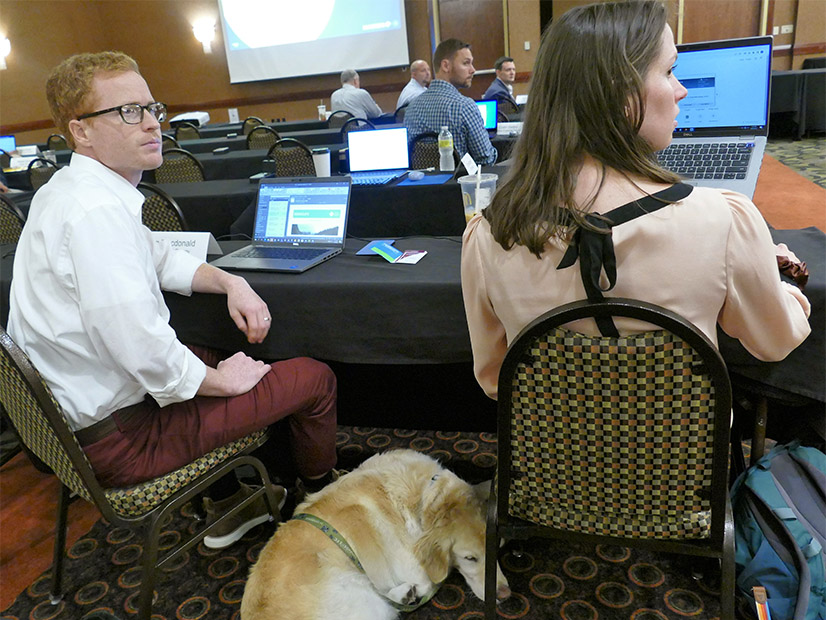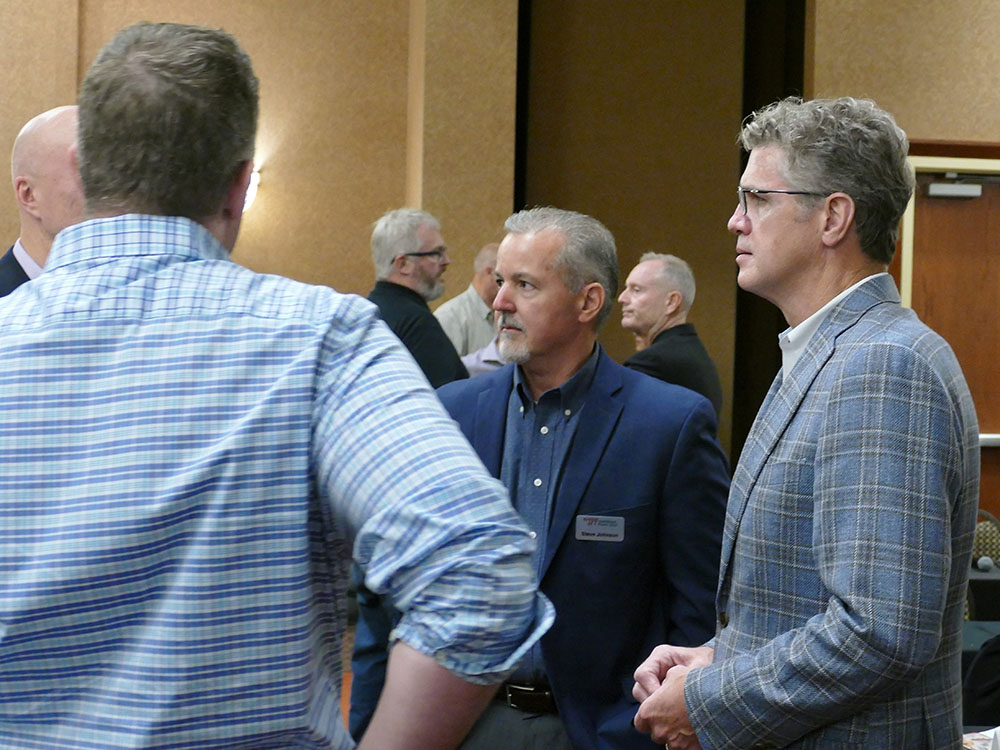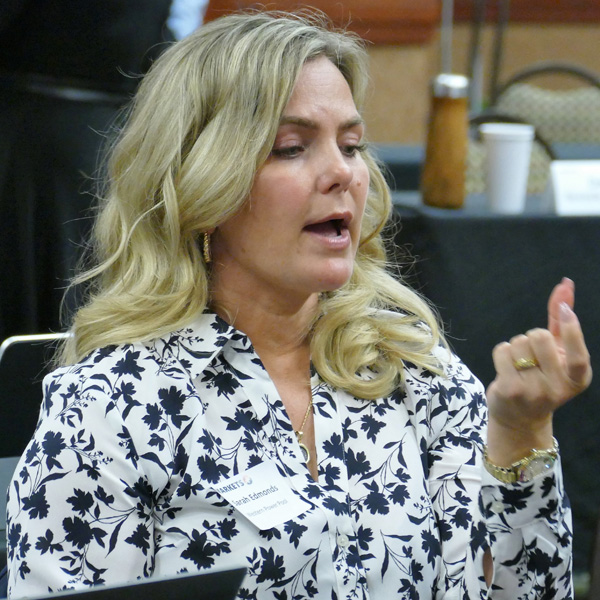
PORTLAND, Ore. — SPP and Western entities interested in the RTO’s Markets+ “RTO light” offering continued to inch toward one another other last week during another development session.
During a discussion on further defining base schedules into various types and their effect on the market, one Western stakeholder cracked, “You even make base schedules fun!”
Those in the know greeted the comment with laughter.
For the uninitiated, base schedules are financial accounting records created by tagging and scheduling bilateral transactions. Should the Markets+ dispatch create an interchange between balancing authorities — there are 38 in the Western Interconnection — the design structure’s dynamic tags will be updated to reflect that dispatch.
 Powerex’s Mark Holman listens to a discussion. | © RTO Insider LLC
Powerex’s Mark Holman listens to a discussion. | © RTO Insider LLC
Mark Holman, managing director of Canadian power marketer Powerex, spoke up frequently during the two-day session, peppering SPP staff and the stakeholder-led design teams with questions of market designs and products.
A conversation on allocating day-ahead congestion rents that left many non-technical attendees lost in the weeds led Holman to remark that the two sides are “down to the final details.”
“I just think this is one of the most complex topics we’re going to tackle,” he said. “We’re trying to allocate congestion rights on top of a multi-[transmission service provider] framework with point-to-point network customers. So, I think we’re in excellent shape on this topic, and I’m really happy how far we’ve gotten in four or five discussions.”
Given a day to think, Holman said the two days were a “tremendous success.”
“Not only was there a great turnout from so many entities across the West, it is now becoming clear that we have general alignment amongst stakeholders on several of the key market design topics. We are already getting down to discussing the finer details,” he said in an email to RTO Insider.
Holman acknowledged there is still work to do but said he is optimistic that SPP staff and those interested in Markets+ will soon have a draft governance and market design proposal with “sufficient detail to support moving to the next phase.”
That would be drawing up a tariff and market protocols, a task that is scheduled to begin next year.
“We’re still talking internally about what that looks like,” Bruce Rew, SPP’s senior vice president of operations, told attendees when the meeting adjourned Wednesday.
 SPP’s Steve Johnson (left) and Bruce Rew listen to Markets+ attendees. | © RTO Insider LLC
SPP’s Steve Johnson (left) and Bruce Rew listen to Markets+ attendees. | © RTO Insider LLC
Until then, the RTO and interested Markets+ participants will develop a draft service offering by the end of September. SPP expects a final service offering to be available in mid-November for what it says is a “conceptual bundle” of services (centralized day-ahead and real-time unit commitment and dispatch, and hurdle-free transmission service across the footprint) for utilities that see value in the services but aren’t ready to pursue full RTO membership.
Eventually, entities interested in membership will be asked to make a financially binding commitment during the first quarter of 2023.
The two sides will gather again in Phoenix in November.
“We’ve learned a lot from those out here, and they’ve learned a lot from us,” SPP General Counsel Paul Suskie said. “I think we’re driving to a strong consensus. I think structurally we’ve got a sound straw proposal, and we’re really just tweaking it.”
Asked what SPP has learned from its potential new members, Suskie said, “What I’ve really learned is there’s a lot of history in the West and because they haven’t had many long-term, successful, regionwide organizations, things are still getting a feel for how to cooperate and work together.”
SPP has said Markets+ will eventually replace the Western Energy Imbalance Service (WEIS) market it currently operates. When three new members join the WEIS next year, it will be regionally balancing 13.5 GW of load generation. Rew has said an imbalance market is a great introduction to markets but is only a short-term solution for participants.
Recent years have seen CAISO also offer RTO services with its Western Energy Imbalance Market (WEIM), and then build on that with its proposed extended day-ahead market (EDAM). Suskie pointed to those advances and that of the Western Power Pool’s Western Resource Adequacy Program (WRAP) as changing attitudes toward regional markets.
 Sarah Edmonds, Western Power Pool | © RTO Insider LLC
Sarah Edmonds, Western Power Pool | © RTO Insider LLC
WPP President Sarah Edmonds framed the WRAP as an industry-driven regional approach to help ensure resource adequacy, given the changing resource mix and its increased resource uncertainty. Participation is voluntary, with members facing mandatory resource requirements. The WRAP’s bilateral transactions under an existing framework is expected to meet estimated peak winter and summer loads of about 66 GW.
SPP is the initiative’s technical services provider, Edmonds said. “They run the studies. They do a lot of the kind of operational facilitation that we’re contemplating for WRAP.”
The program is the West’s take on resource adequacy, she said, which is “part and parcel” of what RTOs do.
“Out here, we’re maybe pivoting towards a slightly different model,” she said. “If WRAP is successful — and so far, we have tremendous momentum and a lot of trust from our members and customers — then there could be a new construct where you’ve got different market operators. There’s more than one in this space right now and a kind of a complementary provider of the resource adequacy program.
“Now, it would necessitate some kind of interplay or coordination between WRAP and these market programs, and the details of that is just something that we haven’t gotten to yet.”
There are also plenty of details to work out with the governance strawman. SPP’s proposal that one of its independent directors be included on the Markets+ Independent Panel (MIP), which would manage the markets and report to the RTO’s Board of Directors, was met with the most pushback. SPP staff have recommended the director have Western experience, but it doesn’t necessarily see that person as the MIP chair.
“Our board picks [its] own chair. I don’t know why MIP can’t pick [its] own chair,” SPP CEO Barbara Sugg said.
“That was just our starting point,” Suskie said.
“If a board member is on the MIP, how is it independent?” asked Western Resource Advocates’ Vijay Satyal. “If you want autonomy, no directors on the MIP is autonomy to me. The director should be ex officio and non voting.”
Staff assured attendees that the MIP’s eventual makeup is up to them. “We’re spending more time discussing this than we ever will in 10 years of Markets+,” Suskie said.
SPP’s takeaways from the governance discussion also included concerns over the $5,000 annual membership fee for non-member participants. Suskie asked for feedback from attendees, noting a waiver might make sense.
“The questions they have today won’t exist two years from now. It takes time to get comfortable with each other in a very diverse stakeholder process,” Suskie told RTO Insider after the meeting adjourned. “You’ve got to have trust, and that takes time to build. I think we’re getting there.”



